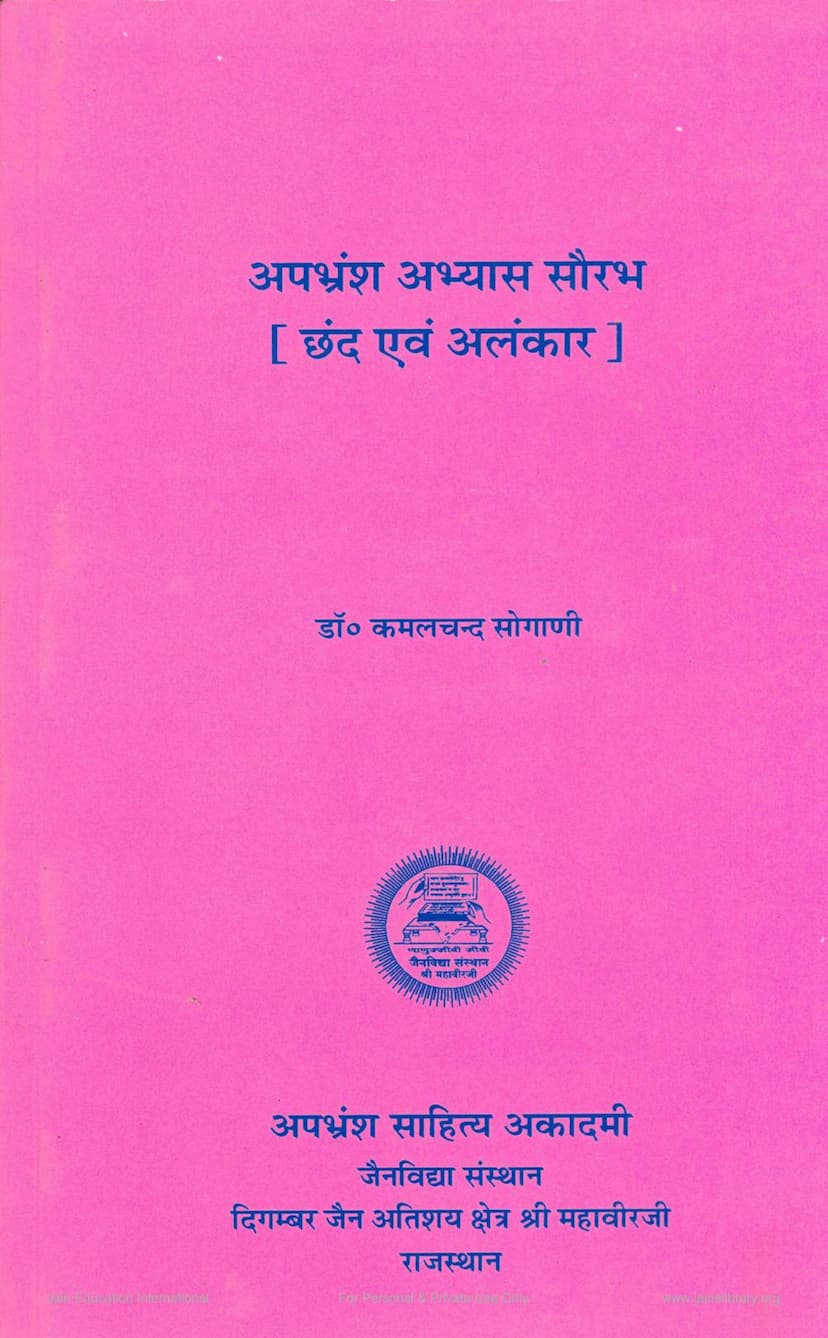Apbhramsa Abhyas Saurabh
Added to library: September 1, 2025

Summary
Here's a comprehensive summary of the Jain text "Apbhramsa Abhyas Saurabh [Chhand evam Alankar]" by Kamalchand Sogani, based on the provided pages:
Book Title: Apbhramsa Abhyas Saurabh [Chhand evam Alankar] (Apprenticship of Apbhramsa: An Anthology of Metre and Figures of Speech)
Author: Dr. Kamalchand Sogani (Former Professor, Philosophy, Sukhadia University, Udaipur)
Publisher: Apbhramsa Sahitya Academy, Jainvidya Sansthan, Shri Mahavirji, Rajasthan.
Edition: Second Edition, 2008
Purpose and Scope:
This book is a foundational text designed to help readers understand and appreciate the intricacies of Apbhramsa poetry, specifically focusing on its metrical patterns (Chhanda) and figures of speech (Alankar). The author emphasizes that Apbhramsa is a rich and vital ancestor of many modern Indian languages and holds significant literary and cultural importance. The book aims to equip readers with the knowledge to identify, analyze, and even compose in Apbhramsa, thereby fostering a deeper understanding of this ancient literary tradition.
Key Content Areas:
The book is structured into two main sections, focusing on metre and figures of speech, with practical exercises for learning.
1. Chhanda (Metre) - Khad 1 (Section 1):
This section delves into the foundational elements of Apbhramsa metre, categorizing them into two primary types:
-
Matrik Chhanda (Syllabic Metres): These metres are based on the count of matras (morae), which represent the duration of sound in pronunciation. The book explains the concept of hrasva (short, 1 matra) and dirgha (long, 2 matras) and provides rules for counting matras, including those related to conjunct consonants, long vowels, nasalization, and final vowel lengths.
- Specific Matrik Chhandas Covered: The book meticulously defines and illustrates numerous Matrik Chhandas, providing their characteristics and examples from Apbhramsa literature. These include:
- Paddhadia
- Simhavalok
- Padakulak
- Vadanak
- Doha
- Chandralekha
- Anand
- Gaha
- Khandayam
- Madhubhar
- Deepak
- Karmakarabhuja
- Madanvilas
- Jambhetia
- Kusumvilasika
- Amarpurasundari
- Charupad
- Gandhodakdhara
- Adilla (Alillah)
- Uppahasini
- Specific Matrik Chhandas Covered: The book meticulously defines and illustrates numerous Matrik Chhandas, providing their characteristics and examples from Apbhramsa literature. These include:
-
Varnik Chhanda (Consonantal Metres): These metres are based on the count of varnas (syllables or letters) and the arrangement of metrical feet (gana). The book explains the eight types of ganas (Yagana, Magana, Tagana, Ragan, Jagan, Bhagan, Nagan, Sagon) and their matra patterns.
- Specific Varnik Chhandas Covered:
- Malati
- Dodhak
- Tottak
- Mautikadam
- Vasantachatar
- Panchachamar
- Specific Varnik Chhandas Covered:
2. Alankar (Figures of Speech):
This section introduces the concept of figures of speech as essential elements for enhancing the beauty and impact of poetry. It categorizes them into two main types:
-
Shabd alankar (Alliterative Figures of Speech): These figures derive their effect from the arrangement and repetition of words or sounds. Their charm is lost if the specific words are replaced by synonyms.
- Specific Shabd Alankars Covered:
- Anupras: Repetition of letters or syllables for sonic effect.
- Yamak: The use of homonyms (words that sound alike but have different meanings).
- Shlesh: A single word having multiple meanings within a sentence.
- Specific Shabd Alankars Covered:
-
Artha Alankar (Figurative Figures of Speech): These figures derive their beauty from the meaning conveyed, not necessarily the specific words used. Synonymous words can often be substituted without losing the rhetorical effect.
- Specific Artha Alankars Covered:
- Upama: Simile, drawing a comparison between two dissimilar things using explicit comparison words. The book details the four components of Upama: Upameya (the subject being described), Upaman (the object of comparison), Sadharan Dharma (common quality), and Vachak Shabd (word of comparison, e.g., 'sa', 'sam').
- Rupak: Metaphor, where the Upameya is directly identified with the Upaman, creating an implied comparison.
- Utpreksha: Hyperbole or imaginative comparison, where a resemblance is suggested or imagined, often using words like 'iva', 'nam', 'navai'.
- Vibhavana: A figure where an effect is produced without an apparent cause.
- Virodhabhas: Paradox or contradiction in terms, where opposing ideas are presented.
- Sandeh: Doubt, where the identity of an object is uncertain, creating a state of suspense.
- Bhrantiman: Misapprehension, where a mistaken identity occurs due to extreme similarity.
- Specific Artha Alankars Covered:
3. Abhyas (Exercises):
Throughout the book, practical exercises are provided. These involve:
- Applying matra counts to given verses and identifying the specific metres.
- Analyzing verses to identify and explain the figures of speech employed.
- These exercises are crucial for reinforcing the theoretical knowledge presented.
4. Chhanda (Metre) - Khad 2 (Section 2):
This section continues the exploration of Apbhramsa metres, introducing more varieties, both Matrik and Varnik.
-
Matrik Chhandas in Khad 2:
- Rayada
- Vilasini
- Mattamatanga
- Nidhiyayika
- Chaupahi (Chatushpadi)
- Madanavatar
- Sariya
- Shashitilak
- Manjari
- Rasakulak
- Shalbhajika
- Heladvipadi
- Kamalekha
- Duvai
- Arnall
- Latakusum
- Tomar
-
Varnik Chhandas in Khad 2:
- Somaraji
- Sragvini
- Samanika
- Chitrapada
- Bhujangaprayata
- Pramanika
Overall Significance:
"Apbhramsa Abhyas Saurabh [Chhand evam Alankar]" serves as a comprehensive manual for understanding the poetic craftsmanship of Apbhramsa literature. By meticulously defining and illustrating various metrical structures and figures of speech, the book empowers students and scholars to engage deeply with this significant period of Indian literary history. The inclusion of exercises makes it a practical guide for learning and application, highlighting the author's dedication to preserving and promoting the study of Apbhramsa. The text underscores the continuity of poetic traditions and the foundational role of Apbhramsa in the evolution of Indian languages and literature.